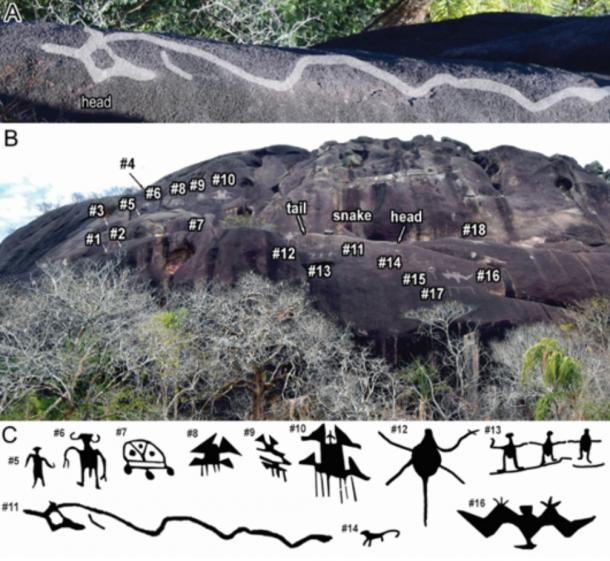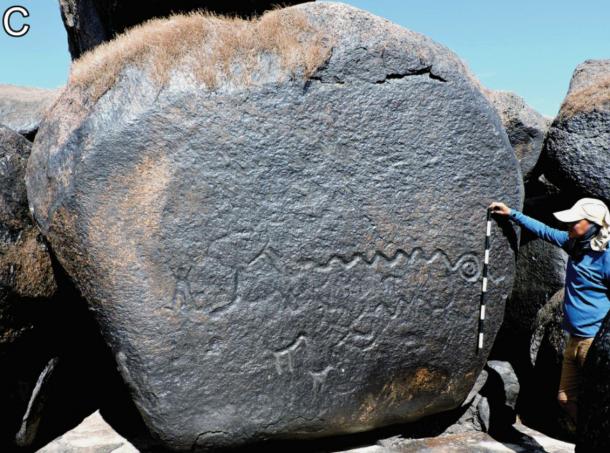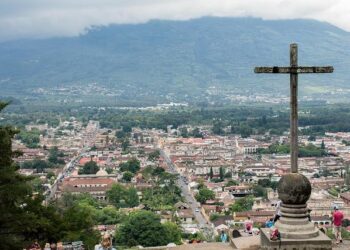In the 18th century, explorers navigating the vast Orinoco River, a major waterway spanning the northeastern corner of South America, reported sightings of numerous rock engravings of snakes adorning the rocky hilltops. Over the centuries, the precise locations of these engravings, now situated in modern-day Colombia and Venezuela, have largely been kept alive through local oral traditions. In a groundbreaking systematic study, contemporary archaeologists have now mapped 14 sites featuring these immense pre-Hispanic artworks, predominantly depicting serpents!┬а
┬а
Rock panel featuring many engravings including a ~42m-long snake, thought to be the largest petroglyph in the world. ( Riris et. al./Antiquity Publications Ltd)┬а
Published in the latest edition of Antiquity, the study confirms both local legends and historical explorersтАЩ accounts, proposing that these engravings may have functioned as ancient border markers or milestones.┬а
The research team visited 157 sites with rock art, with 13 of these sites featuring engravings over a dozen feet tall! A wide variety of figures are depicted, including insects, alligators, stingrays, birds, humans, and other mammals. Among these, 60 individual engravings exceed 30 feet (9 meters) in dimension, including a centipede and two humanoid figures that may represent spirits or gods.┬а
Anything that size is monumental in our view,тАЭтАпexplained Philip Riris, an archaeologist at Bournemouth University and the studyтАЩs lead author, to the New Scientist. тАЬThat means theyтАЩre often visible from quite far away, maybe 500 meters to a kilometer.
┬а
Snake Attack: Myths and Legends┬а
Snakes were the most represented creatures depicted on the rock faces, with the team discovering dozens of engravings. The most remarkable of these was a serpent over 130 feet (39.6 meters) long. According to the mythology of the Indigenous Orinoco people, anacondas and boa constrictors hold a significant place as primordial creators and are highly esteemed, explains Riris.┬а
The Indigenous Piaroa people, who have lived near the Orinoco River for generations, hold that Cu├дmoi (Kuemoi) is an anaconda whose daughter, Cu├дhua, created rock art during her travels along the river. Another Piaroa legend talks of Kuahuayamo Ato, an anaconda who possesses all the regionтАЩs vegetables and swims through the river, singing and crying, which results in the creation of the rock art.┬а
The prevalence of rock art along the river suggests that these ancient carvings may have served as territorial markers to indicate the presence of a particular group, rather than as a warning to stay away.┬а
тАЬThe engravings may not be exclusionary, but rather an inclusionary practice that was shared among the communities,тАЭ suggests Dr. Riris. тАЬтАж There are two sides to these being territorial markers. тАЬOne could be a warning sign тАФ youтАЩre in our backyard, you better behave yourself. The other could be a marker of identity тАФ youтАЩre in our backyard, youтАЩre among friends. But I donтАЩt think they had a single purpose, so they could easily be both.тАЭ┬а
 ┬а
┬а
Example of smaller тАШnon-monumentalтАЩ motifs, including a snake, bird and human at Raudal Palomaz├│n. Note size of the snake relative to other motifs, similar design but a very different size (Riris et. al./Antiquity Publications Ltd).┬а
The Giant Petroglyphs of the Orinoco Region┬а
From at least 9200 years ago, the Orinoco region was inhabited by various Indigenous groups. The diversity in quartz tools, clay pots, and other artifacts suggests that these groups utilized the river as a conduit for trading objects, techniques, and materials, reports The Smithsonian.┬а┬а
By the time the first Spanish arrived in the 14th century, at least seven distinct groups were actively engaged in trading, intermarrying, forming alliances, and engaging in conflicts within a complex political landscape. Some of todayтАЩs Indigenous communities, including the Arawaks and Piaroa, are descendants of these ancient societies.┬а
The study is the culmination of a decade’s worth of fieldwork conducted by Riris and his colleagues, including coauthors Dr. Jos├й Oliver and Natalia Lozada Mendieta. While some of the data collected had been utilized for other research projects, this comprehensive study focuses specifically on the rock engravings along the Orinoco River. Oliver, a reader in Latin American archaeology at University College London, and Lozada Mendieta, an assistant professor of art history at Universidad de Los Andes in Colombia, brought valuable expertise to the team.┬а
The engravings are situated in a region of the river known as the Atures Rapids, recognized as a significant trade and travel route during prehistoric times. Utilizing specialized software, the team reconstructed the viewpoints of ancient inhabitants to visualize how these markings would have appeared to them.┬а
In light of the burgeoning tourism industry in the area, there is a heightened risk of vandalism to these sites. To safeguard them, the researchers have officially registered the sites with Colombian and Venezuelan national heritage bodies, reports CNN.┬а
iframe width=”681″ height=”383″ src=”https://www.ancient-origins.net/news-history-archaeology/https://www.youtube.com/embed/8gwVb7x0X-s” title=”They find in Venezuela the largest petroglyphs in the world, specifically in the Ature rapids.” frameborder=”0″ allow=”accelerometer; autoplay; clipboard-write; encrypted-media; gyroscope; picture-in-picture; web-share” referrerpolicy=”strict-origin-when-cross-origin” allowfullscreen>┬а
The age of the engravings remains undetermined. However, Riris and colleagues hypothesize that the artwork was created around the same period as nearby pottery adorned with similar motifs, which dates from 1030 to 1480 AD.┬а
The researchers aspire to involve local tourism guides and Indigenous communities in further research and preservation efforts, particularly as some of the engravings have been subjected to vandalism. Riris emphasizes that the sheer number of these signs indicates that “in the past, this was a densely occupied part of the South American lowlands,” challenging the contemporary view that the Orinoco region was largely barren and unoccupied before European colonists arrived.┬а
Top image: A variety of the giant petroglyphs discovered along the Orinoco River of Colombia and Venezuela. Source: Riris et. al./Antiquity Publications Ltd┬а
Source link : https://www.ancient-origins.net/news-history-archaeology/giant-petroglyphs-orinoco-0020895
Author :
Publish date : 2024-06-06 10:08:02
Copyright for syndicated content belongs to the linked Source.












